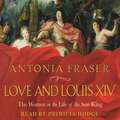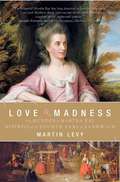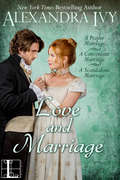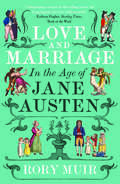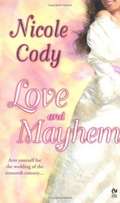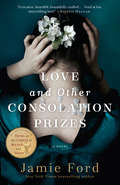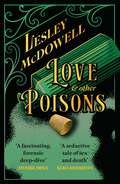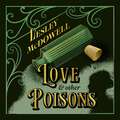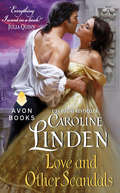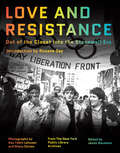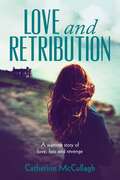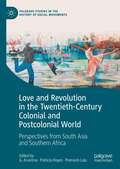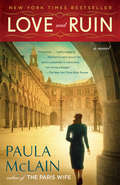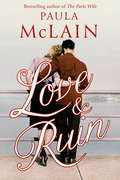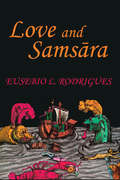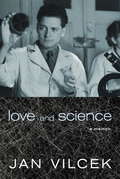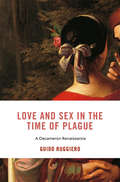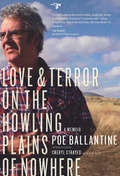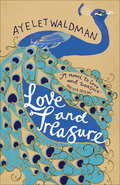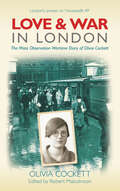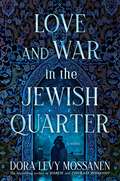- Table View
- List View
Love and Louis XIV: The Women in the Life of the Sun King
by Lady Antonia FraserMistresses and wives, mothers and daughters - Antonia Fraser brilliantly explores the relationships which existed between The Sun King and the women in his life. This includes not only Louis XIV's mistresses, principally Louise de La Vallière, Athénaïs de Montespan, and the puritanical Madame de Maintenon, but also the wider story of his relationships with women in general, including his mother Anne of Austria, his two sisters-in-law who were Duchesses d'Orléans in succession, Henriette-Anne and Liselotte, his wayward illegitimate daughters, and lastly Adelaide, the beloved child-wife of his grandson.Read by Patricia Hodge(p) 2006 Orion Publishing Group
Love and Madness: The Murder of Martha Ray, Mistress of the Fourth Earl of Sandwich
by Martin LevyIn eighteenth-century England the aristocracy dominated the imagination, their exploits -- and misdeeds -- discussed, debated, and gossiped about in the salons and parlors of London. Now author Martin Levy vividly re-creates one of the most shocking and scandalous events of the period, in a riveting true tale of passion, obsession, murder, and courtroom drama. On a spring evening in the year 1779, a young woman emerged from London's Covent Garden Theatre amid a grand swirl of lords and ladies, their servants and coachmen. From out of the shadows a man emerged, dressed in a black suit. He raised a pistol and fired one fatal shot point-blank into the woman's head. A sudden and brutal murder, it was all the more shocking because of the identities of those involved. The victim was Martha Ray, famed aficionada of fashion and the arts, and longtime live-in mistress of the Earl of Sandwich, high-ranking minister to King George III. The assailant was James Hackman, a respected Anglican minister and Martha Ray's former lover. It was a savage crime that rocked both British high society and the church, and inflamed the interest and imagination of such renowned personages as Samuel Johnson and James Boswell, noted biographer and lover of prostitutes and executions. And it resulted in a courtroom extravaganza unique in the annals of legal proceedings -- where passion was the motive, the madness of "momentary phrenzy" the mitigating circumstance . . . and love the ultimate justification for a crazed act of murder. With consummate skill, author Martin Levy brings to breathtaking life the sights and sounds of an unparalleled era in history -- when hangings were public entertainment and debauchery was a popular pastime of the wealthy and the titled -- and expertly unravels the mystery behind a truly sensational slaying. Fascinating, startling, edifying, and entertaining, Love and Madness is a brilliant tale of crime and punishment as vivid and compelling as the headlines of today.
Love and Marriage (bundle set): A Proper Marriage, A Convenient Marriage, A Scandalous Marriage
by Alexandra IvyDear Reader, Long before I wrote my sexy paranormal romances, I wrote traditional Regency romances as Debbie Raleigh. I’m delighted that three of my favorites are now available once more. Here is a trilogy about love, marriage, and the best laid plans . . . After forty years of devoted service, Vicar Humbly is eager to retire to his pleasant cottage and tend to his garden. But before he can live in peace, he must salve his conscience by traveling to the homes of three couples who marriages have troubled him. Though he is a man of the cloth, Vicar Humbly knows that desire sometimes needs a little help from unexpected places . . . and that he may have to be less the Vicar, and more Cupid’s emissary . . . A PROPER MARRIAGEWhen free-spirited Adele Morrow finds herself living a dull existence as wife to a noted scholar, she secretly longs to be carried off by a dashing rogue who will drive her wild with desire. And her husband secretly misses the uninhibited beauty he’d proudly tamed. It seems that every proper marriage deserves a bit of impropriety . . . A CONVENIENT MARRIAGEShy, awkward heiress Beatrice Chaswell is astonished when devastatingly handsome Gabriel Baxtor asks her to be his bride—until she discovers he married her for her money. That may be true, but Gabriel has discovered that his convenient wife is the woman of dreams. Now he must woo her all over again . . . A SCANDALOUS MARRIAGERavishing Victoria Mallory was lucky to find the perfect, gentlemanly fiancé—until a mix-up leaves her locked in a delicious midnight embrace—with another man. Now to avoid scandal she must wed a seductive rogue—one who is equally furious to find himself shackled. But when an intruder breaches their estate they must unite to avert peril—and discover a priceless love . . . I’ve fallen in love with these timeless books all over again, and believe that you will too.
Love and Marriage in the Age of Jane Austen
by Rory MuirWhat happened when Jane Austen’s heroines and heroes were finally wed? Marriage is at the centre of Jane Austen’s novels. The pursuit of husbands and wives, advantageous matches, and, of course, love itself, motivate her characters and continue to fascinate readers today. But what were love and marriage like in reality for ladies and gentlemen in Regency England? Rory Muir uncovers the excitements and disappointments of courtship and the pains and pleasures of marriage, drawing on fascinating first-hand accounts as well as novels of the period. From the glamour of the ballroom to the pressures of careers, children, managing money, and difficult in-laws, love and marriage came in many guises: some wed happily, some dared to elope, and other relationships ended with acrimony, adultery, domestic abuse, or divorce. Muir illuminates the position of both men and women in marriage, as well as those spinsters and bachelors who chose not to marry at all. This is a richly textured account of how love and marriage felt for people at the time—revealing their unspoken assumptions, fears, pleasures, and delights.
Love and Mayhem
by Nicole Cody[From the back cover] Forget the English. Forget the Reformation. Forget your sanity.... Try getting married when your betrothed can wield an iron pot with deadly accuracy, her mad uncle thinks he's William Wallace, and her two maiden aunts can't finish a sentence-or a thought-on their own.... ("Such are Sir Iain Armstrong's travails when he sets out to wed Lady Marion, a convent-raised spitfire. All Iain wants is to fulfill their fathers' wishes, appease two royal courts, and do what is best for the future of Scotland by putting an end to the troubles in his part of the Borders. All Lady Marion has to do is agree to marry him, which is the last thing on her mind when Iain arrives at the convent. She won't be taken without a fight. And even when she realizes that Iain is a man of courage, intelligence, and seductively powerful shoulders, will her eccentric family succeed where her temper tantrums, willful ways, and pride have so far failed- and drive him away forever?
Love and Other Consolation Prizes: A Novel
by Jamie FordFrom the bestselling author of Hotel on the Corner of Bitter and Sweet comes a powerful novel, inspired by a true story, about a boy whose life is transformed at Seattle’s epic 1909 World’s Fair.“An evocative, heartfelt, beautifully crafted story that shines a light on a fascinating, tragic bit of forgotten history.”—Kristin Hannah, author of The Nightingale For twelve-year-old Ernest Young, a charity student at a boarding school, the chance to go to the World’s Fair feels like a gift. But only once he’s there, amid the exotic exhibits, fireworks, and Ferris wheels, does he discover that he is the one who is actually the prize. The half-Chinese orphan is astounded to learn he will be raffled off—a healthy boy “to a good home.” The winning ticket belongs to the flamboyant madam of a high-class brothel, famous for educating her girls. There, Ernest becomes the new houseboy and befriends Maisie, the madam’s precocious daughter, and a bold scullery maid named Fahn. Their friendship and affection form the first real family Ernest has ever known—and against all odds, this new sporting life gives him the sense of home he’s always desired. But as the grande dame succumbs to an occupational hazard and their world of finery begins to crumble, all three must grapple with hope, ambition, and first love. Fifty years later, in the shadow of Seattle’s second World’s Fair, Ernest struggles to help his ailing wife reconcile who she once was with who she wanted to be, while trying to keep family secrets hidden from their grown-up daughters. Against a rich backdrop of post-Victorian vice, suffrage, and celebration, Love and Other Consolations is an enchanting tale about innocence and devotion—in a world where everything, and everyone, is for sale.Advance praise for Love and Other Consolation Prizes“Ford is a master at shining light into dark, forgotten corners of history and revealing the most unexpected and relatable human threads. . . . A beautiful and enthralling story of resilience and the many permutations of love.”—Jessica Shattuck, author of The Women in the Castle“All the charm and heartbreak of Hotel on the Corner of Bitter and Sweet . . . Based on a true story, Love and Other Consolation Prizes will warm your soul.”—Martha Hall Kelly, author of Lilac Girls
Love and Other Poisons: a gripping historical tale of scandal and murder, based on a true story
by Lesley McDowell'A fascinating, forensic deep-dive' DENISE MINA'Beautifully written, richly evoked and utterly gripping' EVA DOLAN 'A seductive tale of sex and death' SARA SHERIDAN***1857, Glasgow.A young socialite named Madeleine Smith stands accused of murdering her lover. Thousands wait outside the court to hear the result. The scandalous nature of the affair, detailed explicitly in letters published in newspapers across the world, has made her case a worldwide sensation. But when the jury find themselves unable to decide whether she is guilty, they render a verdict of 'Not Proven' - and Madeleine is freed.1927, New York.Harry Townsend, a handsome Hollywood film scout believes he has found the woman once known as Madeleine Smith. He wants to tell her story on film for the new 'talkie' generation. Since her trial she has lived under many names, as a glamourous society hostess in bohemian Bloomsbury to the likes of Dante Gabriel Rossetti, George Bernard Shaw and William Morris. Until suddenly, in 1890, when she disappeared off the face of the earth.Could this quiet, secretive widow of an Irish labourer be the same Madeleine Smith who once stood trial for murder and escaped?She has one last secret to reveal. Will Harry persuade her to tell it?***More praise for Lesley McDowell:'Riveting - a clever portrait of a fascinating, flawed heroine.' THE TIMES'An intimate and enlightening tale of one of Romanticism's forsaken muses.' SUSAN STOKES-CHAPMAN'An absorbing, intoxicating page-turner about a woman who deserves to be remembered.' JENNIFER SAINT'A must-read. McDowell brings to vivid, embodied life; a flirtatious, flawed woman fighting for her place in a man's world.' THE HERALD
Love and Other Poisons: a gripping historical tale of scandal and murder, based on a true story
by Lesley McDowell'A fascinating, forensic deep-dive' DENISE MINA'Beautifully written, richly evoked and utterly gripping' EVA DOLAN 'A seductive tale of sex and death' SARA SHERIDAN***1857, Glasgow.A young socialite named Madeleine Smith stands accused of murdering her lover. Thousands wait outside the court to hear the result. The scandalous nature of the affair, detailed explicitly in letters published in newspapers across the world, has made her case a worldwide sensation. But when the jury find themselves unable to decide whether she is guilty, they render a verdict of 'Not Proven' - and Madeleine is freed.1927, New York.Harry Townsend, a handsome Hollywood film scout believes he has found the woman once known as Madeleine Smith. He wants to tell her story on film for the new 'talkie' generation. Since her trial she has lived under many names, as a glamourous society hostess in bohemian Bloomsbury to the likes of Dante Gabriel Rossetti, George Bernard Shaw and William Morris. Until suddenly, in 1890, when she disappeared off the face of the earth.Could this quiet, secretive widow of an Irish labourer be the same Madeleine Smith who once stood trial for murder and escaped?She has one last secret to reveal. Will Harry persuade her to tell it?***More praise for Lesley McDowell:'Riveting - a clever portrait of a fascinating, flawed heroine.' THE TIMES'An intimate and enlightening tale of one of Romanticism's forsaken muses.' SUSAN STOKES-CHAPMAN'An absorbing, intoxicating page-turner about a woman who deserves to be remembered.' JENNIFER SAINT'A must-read. McDowell brings to vivid, embodied life; a flirtatious, flawed woman fighting for her place in a man's world.' THE HERALD
Love and Other Poisons: a gripping historical tale of scandal and murder, based on a true story
by Lesley McDowell'A fascinating, forensic deep-dive' DENISE MINA'Beautifully written, richly evoked and utterly gripping' EVA DOLAN 'A seductive tale of sex and death' SARA SHERIDAN***1857, Glasgow.A young socialite named Madeleine Smith stands accused of murdering her lover. Thousands wait outside the court to hear the result. The scandalous nature of the affair, detailed explicitly in letters published in newspapers across the world, has made her case a worldwide sensation. But when the jury find themselves unable to decide whether she is guilty, they render a verdict of 'Not Proven' - and Madeleine is freed.1927, New York.Harry Townsend, a handsome Hollywood film scout believes he has found the woman once known as Madeleine Smith. He wants to tell her story on film for the new 'talkie' generation. Since her trial she has lived under many names, as a glamourous society hostess in bohemian Bloomsbury to the likes of Dante Gabriel Rossetti, George Bernard Shaw and William Morris. Until suddenly, in 1890, when she disappeared off the face of the earth.Could this quiet, secretive widow of an Irish labourer be the same Madeleine Smith who once stood trial for murder and escaped?She has one last secret to reveal. Will Harry persuade her to tell it?***More praise for Lesley McDowell:'Riveting - a clever portrait of a fascinating, flawed heroine.' THE TIMES'An intimate and enlightening tale of one of Romanticism's forsaken muses.' SUSAN STOKES-CHAPMAN'An absorbing, intoxicating page-turner about a woman who deserves to be remembered.' JENNIFER SAINT'A must-read. McDowell brings to vivid, embodied life; a flirtatious, flawed woman fighting for her place in a man's world.' THE HERALD
Love and Other Scandals
by Caroline LindenTrue Love . . . Joan Bennet has endured four Seasons without a singlesuitor or serious flirtation, let alone a marriage proposal. Shes had just about enough of being a respectablewallflower and is giving serious thought to embarking ona life of sin, or at least lascivious adventure like the onesdescribed in a popular scandalous book. When she meetsher brothers favorite drinking mate, Viscount Burke, it seems her hopes of adventure might be answered . . . Is Worth a Little Scandal . . . Tristan Burke doesnt want a wife, and one cant triflewith a friends sister without risking marriage. Even more, Joans the last sort of woman he would ever choose: droll, sharp-witted, and always unfashionably dressed. If only he could stop thinking about her mouth. Or whatshe might look like without those horrid clothes. Or the way he can only win an argument with her bykissing her senseless . . . even though that just makes himwant her more. But more could lead to a betrothal, which he fears--or does he?
Love and Politics: Persistent Human Desires as a Foundation for Liberation (Routledge Innovations in Political Theory)
by Jeffery L. NicholasIn, Love and Politics Jeffery L. Nicholas argues that Eros is the final rejection of an alienated life, in which humans are prevented from developing their human powers; Eros, in contrast, is an overflowing of acting into new realities and new beauties, a world in which human beings extend their powers and senses. Nicholas uniquely interprets Alasdair MacIntyre’s Revolutionary Aristotelianism as a response to alienation defined as the divorce of fact from value. However, this account cannot address alienation in the form of the oppression of women or people of color. Importantly, it fails to acknowledge the domination of nature that blackens the heart of alienated life. Alienation must be seen as a separation of the human from nature. Nicholas turns to Aristotle, first, to uncover the way his philosophy embodies a divorce of human from nature, then to reconstruct the essential elements of Aristotle’s metaphysics to defend a philosophical anthropology based on Eros. Love and Politics: Persistent Human Desires as a Foundation for Liberation presents a critical theory that synthesizes MacIntyre’s Revolutionary Aristotelianism, Frankfurt School Critical Theory, and Social Reproduction Theory. It will be of great interest to political theorists and philosophers.
Love and Resistance: Out Of The Closet Into The Stonewall Era
by Diana Davies Roxane Gay Jason Baumann Kay Tobin LahusenMore than one hundred vivid photographs of the LGBTQ revolution—and its public and intimate moments in the 1960s and 70s—that lit a fire still burning today. A ragtag group of women protesting behind a police line in the rain. A face in a crowd holding a sign that says, “Hi Mom, Guess What!” at a gay rights rally. Two lovers kissing under a tree. These indelible images are among the thousands housed in the New York Public Library’s archive of photographs of 1960s and ’70s LGBTQ history from photojournalists Kay Tobin Lahusen and Diana Davies. Lahusen is a pioneering photojournalist who captured pivotal moments in the LGBTQ civil rights movement. Davies, in turn, is one of the most important photojournalists who documented gay, lesbian, and trans liberation, as well as civil rights, feminist, and antiwar movements. This powerful collection—which captures the energy, humor, and humanity of the groundbreaking protests that surrounded the Stonewall Riots—celebrates the diversity of this rights movement, both in the subjects of the photos and by presenting Lahusen and Davies’ distinctive work and perspectives in conversation with each other. A preface, captions, and part introductions from curator Jason Baumann provide illuminating historical context. And an introduction from Roxane Gay, best-selling author of Hunger, speaks to the continued importance of these iconic photos of resistance.
Love and Retribution
by Catherine McCullaghIt&’s July 1943 and the world has been at war for almost four long years. One morning, young widow Emmy Penry-Jones discovers two men washed up on the beach below her house on the west coast of Cornwall. Emmy is used to rescuing washed-up sailors, the deadly Battle of the Atlantic exacting a heavy toll on shipping. But these men are not like the shipwrecked sailors she has rescued before and Emmy is soon drawn into a web of intrigue that will test both her ingenuity and her patriotism. Rocked by accusations of war crimes against a man she knows to be innocent, Emmy launches a bid to defend him, all too aware that the accusers could turn on her. The trial marks a turning point and Emmy is drawn further into a deadly cycle of post-war retribution from which only one man can save her.
Love and Revolution in the Twentieth-Century Colonial and Postcolonial World: Perspectives from South Asia and Southern Africa (Palgrave Studies in the History of Social Movements)
by G. Arunima Patricia Hayes Premesh LaluThis book addresses emancipatory narratives from two main sites in the colonial world, the Indian and southern African subcontinents. Exploring how love and revolution interrelate, this volume is unique in drawing on theories of affect to interrogate histories of the political, thus linking love and revolution together. The chapters engage with the affinities of those who live with their colonial pasts: crises of expectations, colonial national convulsions, memories of anti-colonial solidarity, even shared radical libraries. It calls attention to the specific and singular way in which notions of ‘love of the world’ were born in a precise moment of anti-colonial struggle: a love of the world for which one would offer one’s life, and for which there had been little precedent in the history of earlier revolutions. It thus offers new ways of understanding the shifts in global traditions of emancipation over two centuries.
Love and Ruin
by Paula McLainThe internationally bestselling author of The Paris Wife returns to the timeless subject of Ernest Hemingway in this story of his passionate, volatile third marriage to Martha Gellhorn, an ambitious, fiercely independent, beautiful blonde who became one of the greatest war correspondents of the 20th century.In 1937, nervous but determined to succeed, Martha Gellhorn travels alone to Madrid to report on the atrocities of the Spanish Civil War, and finds herself drawn to the stories of ordinary people caught in devastating conflict. She also finds herself unexpectedly—and uncontrollably—falling in love with Ernest Hemingway, a man already on his way to becoming a legend. In the shadow of the impending Second World War, and set against the tumultuous backdrops of Madrid, Finland, China, Key West and especially Cuba, where Martha and Ernest made their home, their relationship and professional careers ignite. But when Ernest publishes the biggest literary success of his career, For Whom the Bell Tolls, they are no longer equals, and Martha must make a choice: surrender to the suffocating demands of a domestic lifestyle, or risk losing her husband by forging a path as her own woman and writer. It is a dilemma that will force her to break his heart, or her own.Advance praise for Love and Ruin:“Wonderfully evocative. . . . [Paula] McLain’s fans will not be disappointed; this is historical fiction at its best, and today’s female readers will be encouraged by Martha, who refuses to be silenced or limited in a time that was harshly repressive for women.”—Library Journal (starred review)“McLain has perfected her dramatic and lyrical approach to biographical fiction, lacing Marty’s ardent inner life into electrifying descriptions of place and action. . . . McLain brings forth the deepest, most ringing elements of both ‘love and ruin,’ the two poles of Marty and Ernest’s tempestuous relationship, a ferocious contest between two brilliant, willful, and intrepid writers. McLain’s fast-moving, richly insightful, heart-wrenching, and sumptuously written tale pays exhilarating homage to its truly exceptional and significant inspiration.”—Booklist (starred review)“If you loved McLain’s 2011 blockbuster The Paris Wife, you’re sure to adore her new novel, which is just as good, if not better.”—AARP
Love and Ruin
by Paula McLainIn 1937, courageous and independent Martha Gellhorn travels to Madrid to report on the atrocities of the Spanish Civil War, and finds herself drawn to the stories of ordinary people caught in devastating conflict. She also finds herself unexpectedly - and uncontrollably - falling in love with Ernest Hemingway, a man already on his way to being a legend. In the shadow of the impending Second World War, and set against the tumultuous backdrops of Madrid, Finland, China, and especially Cuba, where Martha and Hemingway made their home, their relationship and professional careers ignite. But when Hemingway publishes the biggest literary success of his career, they are no longer equals, and Martha must make a choice: surrender to the suffocating demands of a domestic lifestyle, or risk losing her husband by forging her way as her own woman and writer. It is a dilemma that will force her to break his heart, and her own.Based on a true storyMartha Gellhorn was one of the greatest war correspondents of the 20th centuryFOR WHOM THE BELLS TOLLS was dedicated to Martha, and inspired by the time they were together in Spain. It was Hemingway's most successful book to date, it sold half a million copies within months, was nominated for a Pulitzer Prize, and triumphantly reestablished his literary reputation
Love and Ruin
by Paula McLainIn 1937, courageous and independent Martha Gellhorn travels to Madrid to report on the atrocities of the Spanish Civil War, and finds herself drawn to the stories of ordinary people caught in devastating conflict. She also finds herself unexpectedly - and uncontrollably - falling in love with Ernest Hemingway, a man already on his way to being a legend. In the shadow of the impending Second World War, and set against the tumultuous backdrops of Madrid, Finland, China, and especially Cuba, where Martha and Hemingway made their home, their relationship and professional careers ignite. But when Hemingway publishes the biggest literary success of his career, they are no longer equals, and Martha must make a choice: surrender to the suffocating demands of a domestic lifestyle, or risk losing her husband by forging her way as her own woman and writer. It is a dilemma that will force her to break his heart, and her own.Based on a true storyMartha Gellhorn was one of the greatest war correspondents of the 20th centuryFOR WHOM THE BELLS TOLLS was dedicated to Martha, and inspired by the time they were together in Spain. It was Hemingway's most successful book to date, it sold half a million copies within months, was nominated for a Pulitzer Prize, and triumphantly reestablished his literary reputation
Love and Ruin: A Novel
by Paula McLainNEW YORK TIMES BESTSELLER • A powerful novel of the stormy marriage between Ernest Hemingway and Martha Gellhorn, a fiercely independent woman who became one of the greatest war correspondents of the twentieth century—from the author of The Paris Wife and When the Stars Go Dark&“Romance, infidelity, war—Paula McLain&’s powerhouse novel has it all.&”—Glamour NAMED ONE OF THE BEST BOOKS OF THE YEAR BY The Washington Post • New York Public Library • Bloomberg • Real SimpleIn 1937, twenty-eight-year-old Martha Gellhorn travels alone to Madrid to report on the atrocities of the Spanish Civil War and becomes drawn to the stories of ordinary people caught in the devastating conflict. It&’s her chance to prove herself a worthy journalist in a field dominated by men. There she also finds herself unexpectedly—and unwillingly—falling in love with Ernest Hemingway, a man on his way to becoming a legend.On the eve of World War II, and set against the turbulent backdrops of Madrid and Cuba, Martha and Ernest&’s relationship and careers ignite. But when Ernest publishes the biggest literary success of his career, For Whom the Bell Tolls, they are no longer equals, and Martha must forge a path as her own woman and writer.Heralded by Ann Patchett as &“the new star of historical fiction,&” Paula McLain brings Gellhorn&’s story richly to life and captures her as a heroine for the ages: a woman who will risk absolutely everything to find her own voice.
Love and Samsara
by Eusebio L. Rodrigues“Rodrigues uses subtle metaphors of haunting memory to dramatize the Portuguese penetrationof the Arab trading world of the sixteenth century.” —Jaysinh Birjepatil, author of The Good Muslim of Jackson HeightsLove and Samsara is an epic diorama of the world in the early 16th century, stretching from Europe to Asia, taking in Brazil, Africa, the Middle East, India, and then the lands below the wind, the monsoon countries of South East Asia. The hero, a renowned Arab ship pilot, hunted down for eloping with a Jain girl, escapes from their assassins by guiding Vasco da Gama and the Portuguese ships to Calicut, the major emporium of the spice trade. Only later does he realize the tremendous significance of his innocent betrayal, for it leads to the Portuguese imperial domination of the oceansea. This marks a turning point in history, a time when the modern world becomes inexorably linked with power—gunpowder for cannon, printing for the spread of knowledge, and astronomy for a new understanding of the heavens. A time also of significant encounter among the world’s major religions—Christianity, Islam, Judaism, Hinduism, Buddhism and Jainism—with their complex languages, philosophies and theologies. Here is a samsara crowded with adventure, history, tragic love, philosophical speculation, religious confrontation, suspense and mystery, that reaches its climax in 1510 with the Portuguese conquest of Goa.“This is fiction at its best, a masterful multi-layered epic novel, compelling and lyrical at the same time that will challenge and delight any devotee of the genre and of the English language.” —Roberto Severino, Professor Emeritus of Italian, Georgetown University“The most epic novel written about Goa.” —José Pereira, author of Suárez: Between Scholasticism and Modernity
Love and Science: A Memoir
by Jan VilcekLong before he became one of the world's most celebrated immunologists, Jan Vilcek began life in Slovakia as the child of Jewish parents at a time when Jews were being exterminated all across Europe. He owes his and his mother’s survival to the courage of brave people and good luck. As a young man growing up in Czechoslovakia in the aftermath of the Second World War, Vilcek went to medical school and chose a career in virology and immunology at a time when these fields were still in their infancy. While still in his twenties he published a paper in the prestigious journal Nature, and he hosted the first international conference on interferon. Fleeing Communist Czechoslovakia with his wife Marica, Vilcek continued his research at NYU School of Medicine, going on to establish a highly successful career in biomedical research, and creating one of the most important and trailblazing medicines of our age. After his arrival in the US in 1965 as a penniless refugee, he soon went on to spearhead some of the key advances in the research of interferon that enabled its therapeutic application, and through his research into tumor necrosis factor (TNF) made advances that led to the discovery of new genes and proteins and signaling pathways, opening up previously uncharted areas of medical innovation that have led to important new treatments for a wide range of autoimmune and inflammatory diseases. Along the way Vilcek acquired material wealth he had never aspired to, catapulting him into the world of philanthropy. Love and Science shows how advances in science sometimes result from the greatest disappointments, and how achievement in medical research is usually a team effort, where ideas are shared, where friendship and love sometimes matter most and serendipity is as important as a will to succeed—and where, over time, the least expected thing sometimes becomes the most important. In Vilcek's case the vaunted cure for cancer that many saw in TNF never materialized. However, out of the ashes of that hope came many related treatments that have changed countless lives and alleviated much suffering.From the Hardcover edition.
Love and Sex in the Time of Plague: A Decameron Renaissance (I Tatti Studies In Italian Renaissance History Ser. #28)
by Guido RuggieroAs a pandemic swept across fourteenth-century Europe, the Decameron offered the ill and grieving a symphony of life and love. For Florentines, the world seemed to be coming to an end. In 1348 the first wave of the Black Death swept across the Italian city, reducing its population from more than 100,000 to less than 40,000. The disease would eventually kill at least half of the population of Europe. Amid the devastation, Giovanni Boccaccio’s Decameron was born. One of the masterpieces of world literature, the Decameron has captivated centuries of readers with its vivid tales of love, loyalty, betrayal, and sex. Despite the death that overwhelmed Florence, Boccaccio’s collection of novelle was, in Guido Ruggiero’s words, a “symphony of life.” Love and Sex in the Time of Plague guides twenty-first-century readers back to Boccaccio’s world to recapture how his work sounded to fourteenth-century ears. Through insightful discussions of the Decameron’s cherished stories and deep portraits of Florentine culture, Ruggiero explores love and sexual relations in a society undergoing convulsive change. In the century before the plague arrived, Florence had become one of the richest and most powerful cities in Europe. With the medieval nobility in decline, a new polity was emerging, driven by Il Popolo—the people, fractious and enterprising. Boccaccio’s stories had a special resonance in this age of upheaval, as Florentines sought new notions of truth and virtue to meet both the despair and the possibility of the moment.
Love and Terror on the Howling Plains of Nowhere
by Cheryl Strayed Poe BallantineFans of Truman Capote's In Cold Blood and John Berendt's Midnight in the Garden of Good and Evil will embrace Poe Ballantine's Love and Terror on the Howling Plains of Nowhere.For well over twenty years, Poe Ballantine traveled America, taking odd jobs, living in small rooms, and wondering the big whys. At age 46, he finally settled with his Mexican immigrant wife in Chadron, Nebraska, where they had a son who was red-flagged as autistic. Poe published four books about his experiences as a wanderer and his observations of America. But one day in 2006, his neighbor, Steven Haataja, a math professor from the local state college disappeared. Ninety five days later, the professor was found bound to a tree, burned to death in the hills behind the campus where he had taught. No one, law enforcement included, understood the circumstances. Poe had never contemplated writing mystery or true crime, but since he knew all the players, the suspects, the sheriff, the police involved, he and his kindergarten son set out to find out what might have happened.
Love and Treasure
by Ayelet Waldman'A NOVEL TO LOVE AND TREASURE' PHILIPPA GREGORY'REMARKABLE' MICHAEL ONDAATJE'POIGNANTLY MOVING' JOYCE CAROL OATES Salzburg, 1946. A fugitive train loaded with the plunder of a doomed people. A dazzling, jewel-encrusted, peacock-shaped pendant. And three men - an American lieutenant who fought in WWII, an Israeli-born dealer of Nazi plunder, and a pioneering psychiatrist in fin-de-siècle Budapest - who find their carefully-wrought lives turned upside-down by three fierce women, each locked in a struggle against her own history and the history of their times. Spanning continents and a century marked by war and revolution, Love and Treasure is by turns funny and tragic, thrilling and harrowing, mapping the darkness of a shattered Europe against the heartbreak of a modern New Yorker. Told through the prism of the peacock pendant, the novel charts the ebb and flow of history, fate and fortune from 1914 Budapest to present-day New York. And at the centre of Love and Treasure, nested like a photograph hidden in a locket, a mystery: where does the worth of a people and its treasures truly lie? What is the value of a gift, when giver and recipient have been lost - of a love offering when the beloved is no more?'AN AMBITIOUS, PERCEPTIVE NOVEL' GUARDIAN'A WONDERFULLY IMAGINATIVE WRITER' WASHINGTON POST
Love and War in London: The Mass Observation Wartime Diary of Olivia Cockett
by Robert Malcolmson Olivia CockettLove & War in London is rooted in the extraordinary milieu of wartime London. Vibrant and engaging, Olivia Cockett’s diary reveals her frustrations, fears, pleasures and self-doubts. She recorded her mood swings and tried to understand them, and wrote of her lover (a married man) and the intense relationship they had. As she and her friends and family in New Scotland Yard were swept up by the momentous events of another European war, she vividly reported on what she saw and heard in her daily life. Hers is a diary that brings together the personal and the public. It permits us to understand how one intelligent, imaginative woman struggled to make sense of her life, as the city in which she lived was drawn into the turmoil of a catastrophic war.
Love and War in the Jewish Quarter
by Dora Levy MossanenA breathtaking journey across Iran where war and superstition, jealousy and betrayal, and passion and loyalty rage behind the impenetrable walls of mansions and the crumbling houses of the Jewish Quarter.Against the tumultuous background of World War II, Dr. Yaran will find himself caught in the thrall of the anti-Semitic Governor General, the most powerful man in the country. Dr. Yaran falls in love with the Governor General&’s defiant wife, Velvet, upending not only the life of the doctor&’s beloved daughter, but the entire community. In his quest to save everything and everyone he loves, Dr. Yaran will navigate the intersections of magic, science, lust, and treachery. His sole ally is the Governor General&’s servant, an exotic eunuch, who will do anything to aid his mistress in her dangerous quest to attain forbidden love.
